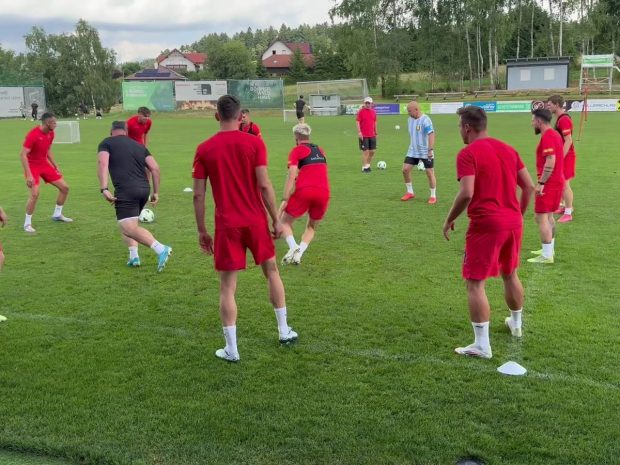The Uber driver wore a vintage black Real Madrid jersey. The name and number on the back, in Wanted Poster font, belonged to Zinedine Zidane. He was from El Salvador and, as he drove to the Hard Rock stadium in Miami Gardens, he explained why he was Madridista. “Have you seen Goal?” he excitedly asked.
Advertisement
The trilogy of films charts the rise of an undocumented Mexican immigrant, who gets spotted by Newcastle United in Los Angeles. The sequel, entitled Living The Dream, is about the protagonist’s move to — where else? — Real Madrid, where he wins the Champions League alongside David Beckham. The Goal series did not transcend like Ted Lasso. The movies were not box office hits. The one featuring Madrid took less than $8m at the box office worldwide, less than an average Madrid player’s salary. But the films spoke to this Uber driver who grew up on the other side of the Atlantic. They helped turn him into a Madridista.
To say Madrid are one of, if not the biggest clubs in the world is to state the obvious. And yet it is still incredible to observe firsthand, on a continent that isn’t their own.
At the Club World Cup the primacy of their pulling power is beyond dispute. Boca Juniors’ opening game against Benfica at the Hard Rock was widely heralded as the first to have a genuine atmosphere at the tournament. Their supporters brought noise and, crucially, authenticity to the Club World Cup. They were billed as its saviours. But that game was also the one with the lowest crowd at the Hard Rock (55,574).
The closest thing to a guaranteed near sell-out at the Club World Cup hasn’t been Boca or Lionel Messi. It has been Madrid. Again, few will be surprised. But to see it manifest in the way it has in the U.S is awe-inspiring. At a tournament where much of the focus has been on sparse attendances, Madrid have got bigger crowds than anyone, drawing on average of 67,247. Few seats have been left in the house. Pricing has not been dynamic insofar as tickets to their games have, mostly, held their value.
At the Bank of America Stadium in Charlotte, 70,248 turned out to watch Madrid play Pachuca. The average gate at that ground during the Club World Cup has been… 37,000. Madrid’s quarter-final against Borussia Dortmund at MetLife was bigger, fetching 76,611. This outperformed all previous games at the same site by a considerable margin. For context, the average turn-out at MetLife has been 43,000.

Madrid’s quarter-final against Dortmund at MetLife (Al Bello/Getty Images)
“There’s nothing like Madrid, no club in the world,” Charlie Stillitano says. He was the sports exec to whom Madrid and others trusted the organisation of multi-million dollar friendlies in the U.S.
On the one hand, the reaction is still: well, duh. Who knew people would pay to see the most successful club in the world, the one with twice as many Champions League titles as their next rival and more, the team for whom guys like Kylian Mbappe and Trent Alexander-Arnold would leave their hometown clubs PSG and Liverpool because, well, Madrid es Madrid. Massive and mythical.
Advertisement
“The rise of soccer fans in the U.S. has really been attracted to the English Premier League since around 2010,” Stillitano continues. “They benefit a lot. But Madrid also has another component that is extraordinary.”
Nearly 20 per cent of the U.S population in 2023 was Hispanic, according to the U.S. Census Bureau. That’s 65 million people. Barcelona have been able to tap into this market too but they haven’t won the Champions League for a decade. Madrid, in the meantime, have lifted it four times and recency, being in the final almost once every two years, matters as much as heritage.
“You can ask everyone in Mexico: ‘What’s your favourite team?’ And they might say Club América or Chivas, as an example,” Stillitano explains. “But 80 per cent when you say: ‘What’s your second favourite team?’ They’ll all tell you Real Madrid or Barcelona.” And that was probably true of some of the Pachuca supporters in Charlotte; double bubble. They got to see both Madrid and Pachuca.

(Pedro Castillo/Real Madrid via Getty Images)
Internally at Madrid, they refer to the “engagement pyramid” as they assess the development of their fanbase.
“There are fans who wake up in the morning and the first thing they think about is their football club,” explains one Madrid executive, speaking anonymously as they were not authorised to speak publicly. “Then they remember that they have a family and children.
“There are then people who don’t really watch football but if you ask them, they say ‘Well, I don’t love football but if I have to choose, it is between Barcelona and Madrid.’ The people on the top of the pyramid are people who really have a lot of engagement with the brand and then at the bottom, in the basement, there are those with lower investment and engagement.
“For Madrid in the U.S., there’s more people joining the basement and more people going up the pyramid and becoming a more intense fan. This is why it’s such an important and strategic market.”
Advertisement
Madrid have, at times, even surprised themselves. Florentino Perez’s predecessor as president, Ramon Calderon, remembers being taken aback almost two decades ago when Madrid played Real Salt Lake, a club named in their honor, in Utah in front of a full house.
“We managed to help to break the ground for the new stadium,” he recalls. “I think it was the first stadium only for soccer. Tom Cruise came to that match. I met him and his wife. He was very, very kind and he came when we played our last match and won La Liga (in 2007). (David) Beckham was playing with us and I realised for the interest of the press, the media in general, the TV that really, really we were a very important brand. All the presidents, I’m sure, we are proud that we managed to get it to this level.”
The assumption is that it has always been this way since time immemorial. But Madrid, the 15-time winners of the Champions League, went 32 years without winning it between 1966 and 1998.
“In the old days, at the start of the 21st century,” Stillitano says, as if it were the Jurassic age of football, “the No 1 team here was Man United, hands down. The number two and three were Juventus and AC Milan. And four was probably Real Madrid. I’m talking 2002. This growth and strategy is deliberate. It’s absolutely down to Florentino Perez.”
The Club World Cup is, in some respects, very Perez-ian, and maybe the two are made for each other. As an example of Madrid doing things their own way, the club’s pre-semi-final press conference at MetLife was cancelled at the last minute on Tuesday night. This was because the team and manager Xabi Alonso were circling somewhere over Washington D.C. at the time they were due to appear after storms had delayed their flight north from Miami, where they had opted to return to train in Palm Beach after their quarter-final win in New Jersey. It is about 1,200 miles between the two venues.
And, however flawed, the Club World Cup is conceptually about bringing together the best; sport as stargazing. That was what underpinned the Galacticos project at Madrid too; Perez’s policy of signing the most talented and highest-profile players in world football.
“The Galacticos project, even though it wasn’t the best from the point of view of football… the popularity rocketed with (Luis) Figo, Zidane, Ronaldo and finally Beckham,” Calderon concedes. “That was, I think, very important for the popularity and the image of the club around the world.”
Advertisement
He claims Beckham’s unveiling as a Madrid player was “the world’s second-largest live TV audience ever after Princess Diana’s funeral, so something really amazing. We knew that that was really the turning point of our popularity in the world. That has been very interesting in order to know how much football can be important in the U.S.”

(Shaun Botterill/Getty Images)
And yet Madrid still needed coaxing stateside. They were resistant and did not initially see the benefit of playing prestige friendlies against big European teams or, worse, prospective rivals for the Champions League in the U.S. They feared their opponents might learn about Madrid and use the experience when it mattered in an actual knockout game later in the season.
“When I started in this business, we had these teams coming over here and the first game we did was Real Madrid against Roma, August 8, 2002,” Stillitano recalls. “Half the stadium was Roma. Half the stadium was Real Madrid. And I remember after the game Florentino Perez said to me: ‘I don’t want you to bring another big Italian team because the Italian teams were big back then with stars like Gabriel Batistuta and Cafu. They have a real good team.’ He said: ‘I want to play local teams because I want everyone to come and see Real Madrid’.”
The focus had to be on them and, boy, how it would be like never before when the coincidence of social media’s explosion with the multiplier effect Cristiano Ronaldo and Lionel Messi had on the Madrid-Barcelona rivalry took both clubs to a whole new level.

Ronaldo in the white of Madrid (Denis Doyle/Getty Images)
Madrid, as Calderon says, had already laid foundations in the U.S. “We built academies in America, partnered with American brands to be visible there. And we’ve participated in exhibition tournaments. We had over 40 fan clubs in the U.S up to now, which is not bad, taking into account that soccer is not the most popular sport in the U.S.”
But Ronaldo and Messi supercharged interest. Stillitano understandably wanted to take El Clasico to the U.S, even as a friendly. Once again, he encountered some initial reluctance.
“It was very difficult to persuade them,” he says. “Actually, the presidents were both in favour of it but the other people, some at executive level, were more reluctant. There were a number of reasons. One was sporting. They didn’t want it to lose its lustre as a game. But there was also the problem of when you have these games in pre-season. If the team beats you 5-0 you’re in crisis. That’s changed over time, for sure. And I think that’s changed because we had big teams play big teams and they saw it didn’t ruin their season.”
Advertisement
In 2017, the Clasico finally came to the U.S. The Hard Rock was the stage for a 3-2 win for Barcelona, as Messi, Luis Suarez and Neymar overcame a Madrid team featuring Karim Benzema and Gareth Bale. The inaugural ‘friendly’ between them brought in a remarkable $35.5million in gate receipts.
More have subsequently been organised in Las Vegas, New York and Dallas where NBA star Luka Doncic used to play before his move to the Lakers in the most jaw-dropping trade of all-time. Doncic’s place in American sports culture and his past as a Madrid basketball player is another one of those crossover moments that hardly hurts Madrid achieving even greater mainstream brand recognition in the U.S.

(ANDREJ ISAKOVIC/AFP via Getty Images)
While Barcelona’s absence from the Club World Cup, not to mention that of Liverpool and other domestic champions, has left a hole in it, Madrid have almost single-handedly covered up for it. Before Madrid played their Club World Cup opener against Al-Hilal, Perez said: ‘This competition means a lot. I want to thank FIFA and DAZN (the host broadcaster) for allowing the best clubs in the world to play in such a beautiful competition, the first Club World Cup, which I am sure will be a success, and we are all looking forward to it.
“We have finally achieved something we have been fighting for for a long time.”
If not a Super League, then, in his eyes, the next best thing: a Club World Cup.
Winning it would not only confer a legitimacy on this tournament in the same way Madrid did the old European Cup by winning its inaugural edition, it would perhaps cement their claim to something else. Madrid would not only be world champions. They would consolidate something they have been building for a quarter of a century; they are more than just a Spanish team.
They are the team of the Americas and America’s team.
(Top photos: Emilee Chin, Franck Fife, Justin Statloff, David Ramos, Getty Images; design: Kelsea Petersen/The Athletic)
This news was originally published on this post .





Be the first to leave a comment